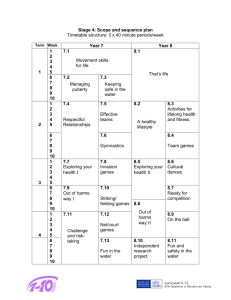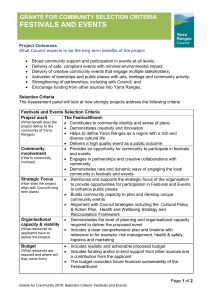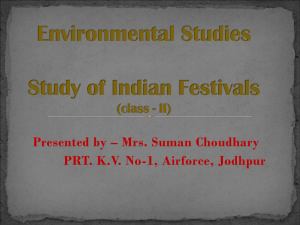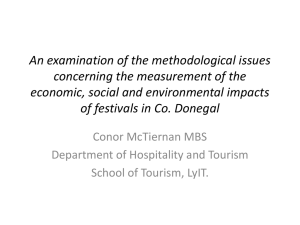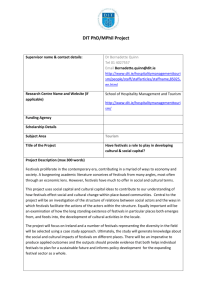Preventing Drug- and Alcohol-related Harms at Music Festivals in
advertisement
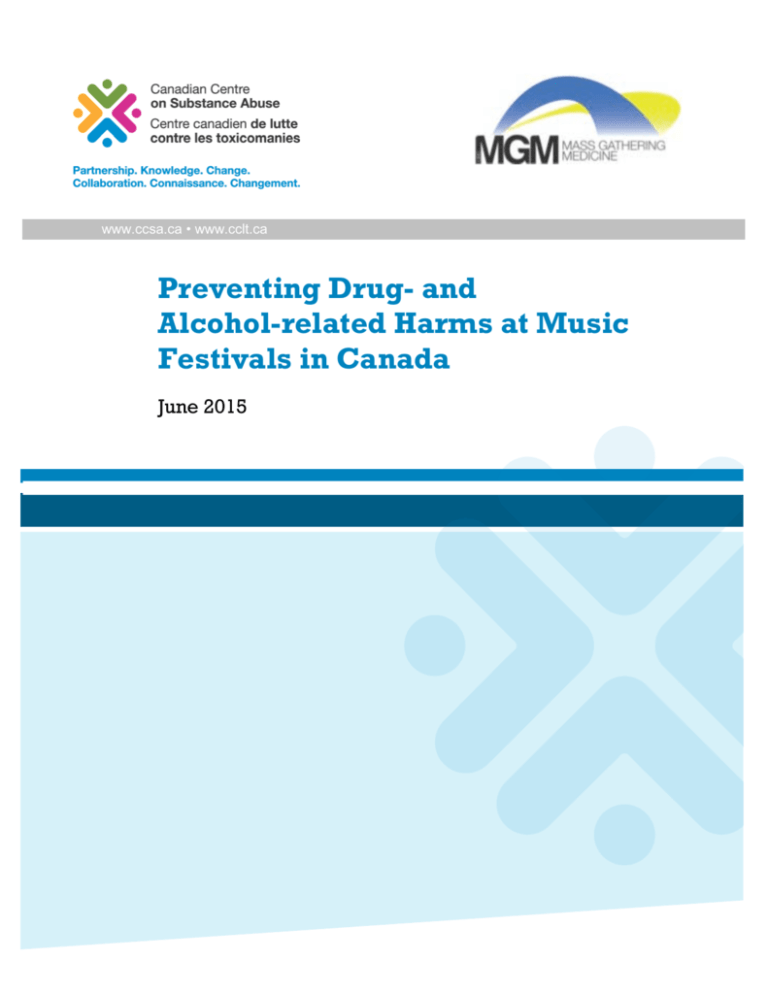
www.ccsa.ca • www.cclt.ca Preventing Drug- and Alcohol-related Harms at Music Festivals in Canada June 2015 Preventing Drug- and Alcohol-related Harms at Music Festivals in Canada June 2015 This document was published by the Canadian Centre on Substance Abuse (CCSA). Suggested citation: Young, M.M., Diedrich, K., Pirie, T., Lund, A., Turris, S., & Bowles, R. (2015) Preventing Drug- and Alcohol-related Harms at Music Festivals in Canada. Ottawa, Ontario: Canadian Centre on Substance Abuse. © Canadian Centre on Substance Abuse, 2015. CCSA, 500–75 Albert Street Ottawa, ON K1P 5E7 Tel.: 613-235-4048 Email: info@ccsa.ca Production of this document has been made possible through a financial contribution from Health Canada. The views expressed herein do not necessarily represent the views of Health Canada. This document can also be downloaded as a PDF at www.ccsa.ca Ce document est également disponible en français sous le titre : Prévenir les méfaits liés à la drogue et à l’alcool lors de festivals de musique au Canada ISBN 978-1-77178-267-8 Preventing Drug- and Alcohol-related Harms at Music Festivals in Canada Report prepared by: Matthew M. Young, PhD Senior Research & Policy Analyst/Analyste Principal, Recherche et politiques Adjunct Research Professor, Carleton University, Ottawa, ON Tyler Pirie, MSc Research and Policy Analyst/Analyste, Recherche politiques Karine Diedrich National Priority Advisor/Conseillère, Priorités nationales In collaboration with: Adam Lund, MD, MEd, FRCPC (Emergency) Clincial Associate Professor, Department of Emergency Medicine, University of British Columbia (UBC) Founder, Mass Gathering Medicine Interest Group Sheila Turris, NP, PhD Adjunct Professor, Department of Emergency Medicine, UBC Chair, Mass Gathering Medicine Interest Group Ron Bowles, PhD Associate Dean, Office of Applied Research Justice Institute of British Columbia Canadian Centre on Substance Abuse • Centre canadien de lutte contre les toxicomanies Preventing Drug- and Alcohol-related Harms at Music Festivals in Canada Table of Contents Summary ............................................................................................................ 1 Stakeholder Meeting ........................................................................................... 2 Priority Areas for Action................................................................................... 2 A. B. C. D. Event organization and design ............................................................ 2 Promotion of health and reduction of harms ......................................... 3 Mass gathering medicine .................................................................... 4 Enforcement and event security .......................................................... 5 Next Steps .......................................................................................................... 5 Appendix A: Meeting Attendees ............................................................................ 6 Canadian Centre on Substance Abuse • Centre canadien de lutte contre les toxicomanies Preventing Drug- and Alcohol-related Harms at Music Festivals in Canada Summary Between June and August 2014, at least five young adults died while attending Canadian music festivals, and many more individuals were treated on site or admitted to hospital. It is suspected that use of alcohol or drugs or both might have been a contributing factor in these deaths and illnesses. However, there are no consistent national or provincial guidelines aimed at preventing or responding to drug- and alcohol-related harms at these events. To discuss how to prevent drug- and alcohol-related harms at Canadian music festivals, a national meeting of diverse stakeholders with expertise in health promotion and harm reduction, toxicology, substance use epidemiology, pre-hospital and emergency care, law enforcement, festival production, event security services, and policy and permitting was held in January 2015. The following recommendations emerged from this meeting: Event organizers and promoters, police and security personnel, medical and health promotion professionals and community leaders need to work together to address four priority areas: A. Event organization and design Engage early and often with community stakeholders; ensure adequate hydration and sanitation resources and facilities are available; and improve the rapid exchange of information about known drug risks. B. Promotion of health and reduction of harms Provide safe physical spaces separate from the crowd (safe or chill space); disseminate appropriate messages about substance use at festivals; and give further consideration and investigation of the impact of drug checking or testing services. C. Mass gathering medicine (delivery of health care at mass gatherings) Develop an optimal medical response for music festivals; support collaborative research; and build the capacity of medical professionals to work at music festivals. D. Enforcement and event security Develop a national framework or common approach that can be adapted, based on needs and capacity, to enhance and standardize security practices across events and jurisdictions; improve real-time monitoring; and share suspected drug incidents or other health concerns with event staff and stakeholders immediately. Working groups are being established to advance these priorities, with a view to ensuring evidencebased policies and practices are adopted at music festivals to reduce substance-related harms. Canadian Centre on Substance Abuse • Centre canadien de lutte contre les toxicomanies Page 1 Preventing Drug- and Alcohol-related Harms at Music Festivals in Canada Stakeholder Meeting In the absence of national or provincial guidelines for preventing or responding to drug- and alcoholrelated harms at music festivals, the Canadian Centre on Substance Abuse (CCSA) and the University of British Columbia’s Mass Gathering Medicine Interest Group (UBC MGM) convened a meeting of stakeholders in Vancouver, British Columbia, on January 19 and 20, 2015. The goal of this meeting was to gain a better understanding of the scope of the issue and associated risks, and to develop recommendations for preventing and responding to drug- and alcohol-related harms at these events. The two-day meeting included a diverse group of invited stakeholders. The thirty-five attendees from across Canada and the United States represented a wide variety of perspectives, including health promotion and harm reduction, toxicology, substance use epidemiology, pre-hospital and emergency care, law enforcement, festival production, event security services, and policy and permitting (see Appendix A, Meeting Attendees). On the first day, invited speakers presented their perspectives on festival safety. In the afternoon, facilitated discussions in small groups identified barriers to event safety, highlighted outstanding questions, and brainstormed suggestions aimed at preventing, preparing for and responding to drugand alcohol-related harms at music festivals. On the second day, the ideas and questions generated the previous afternoon were grouped into themes and priority areas for attention. Participants identified those areas as most pressing and as having the greatest possible impact in reducing the risk of drug- and alcohol-related harms at future events through a weighting exercise in which participants voted for areas they felt were most important and indicated areas where there were concerns (e.g., feasibility of implementation uncertain, questionable supporting evidence, etc.). Participants concluded the day by indicating which priority areas they were most interested in moving ahead with and the extent to which they wished to be actively involved in taking the next steps. Priority Areas for Action By the end of the meeting, the group had identified several priority areas for action. The priority areas are grouped into one of four categories: (A) event organization and design; (B) promotion of health and reduction of harms; (C) mass gathering medicine (delivery of health care at mass gatherings) (D) enforcement and event security. The top three priority areas for action within each category, as identified by the group, are summarized below. A. Event organization and design 1. Early and ongoing engagement of community stakeholders. Event organizers need to engage with community stakeholders throughout the organizing, permitting and planning processes. By engaging local community and health stakeholders, event organizers are able to develop relationships with community-based services (e.g., ambulance, hospital and police) that can contribute to safer festivals. 2. Adequate hydration and sanitation resources. Meeting participants agreed on the need for adequate hydration and sanitation resources. It is essential for festivals to provide reliable access to free potable water. Guidelines for festival organizers to follow should be developed to ensure adequate hydration of attendees (e.g., minimum number of spigots per number of festival attendees, guidelines for placement of sanitation facilities). Canadian Centre on Substance Abuse • Centre canadien de lutte contre les toxicomanies Page 2 Preventing Drug- and Alcohol-related Harms at Music Festivals in Canada 3. Rapid knowledge exchange about known drug risks. Participants recommended that a way to more rapidly share information of known drug risks before, during and after festivals be established. This sharing could include: • Using social media and other tools to warn festival attendees, organizers, medical personnel and security services of emerging or ongoing drug-related harms; • Improving knowledge sharing between those working off-site to promote health and reduce harms and on-site medical and security teams; and • Sharing lessons learned after an event with upcoming festivals so that these organizers are aware of new alcohol and other drug trends, and can learn from experience. Note: Meeting attendees had concerns about the feasibility of implementing a system that could rapidly collect and disseminate accurate information. Participants identified other areas of action associated with event organization, including developing and disseminating public service announcements before and during events; leveraging social media for two-way communication with attendees and staff; and non-judgmental training for all appropriate event personnel on substance use behaviours and predictable drug- and alcohol-related clinical presentations and harms, and how to respond effectively. B. Promotion of health and reduction of harms 1. Provide safe physical spaces separated from the crowd (safe or chill space). Organizers should provide a physical space on festival grounds where those experiencing undesirable effects from intoxicating substances can get away from the noise and activity of the festival. Services that could be provided in this space include screening for dangerous medical presentations and peer support for those suffering difficult drug or alcohol experiences without medical complications. Frequently referred to as “trip sitting,” trained peers provide assistance to those who might be experiencing anxiety, depression or other mental states likely exacerbated by substance use or environmental factors. 2. Disseminate appropriate messages about substance use at festivals. Any type of campaign aimed at reducing drug- and alcohol-related harms at music festivals requires that substance use prevention messages be developed and delivered. All messaging should be based on the best available evidence and be non-judgmental. Participants emphasized peer-to-peer delivery as an important element of any messaging or campaign. 3. Consider or further investigate the impact of drug checking and testing services. Drug checking and testing is a strategy used by some harm-reduction programs to test the contents of pills and powders. 1 The value of drug checking is vastly diminished if not paired with appropriate education and messaging to highlight limitations, give context to test results and deliver appropriate messages about substance use. Note: Several attendees raised concerns about legality and liability issues surrounding drug checking and testing. (Example: tests involve the possession of controlled substances on or just outside of the premises.) Other areas for action included having drug- and alcohol-free zones; setting up booths to distribute free health promotional materials (e.g., condoms, including female condoms, sunscreen, ear plugs, electrolytes, water, ice, syringes, sterile water, etc.) and offer health 1 Portable drug testing kits have been designed for on-site spot testing of substances. The test is conducted by putting a small sample of the drug into an empty vial or small bag followed by one drop of a reagent liquid. Once mixed, the sample will change color and the result is compared to a color wheel to identify the drug. Canadian Centre on Substance Abuse • Centre canadien de lutte contre les toxicomanies Page 3 Preventing Drug- and Alcohol-related Harms at Music Festivals in Canada education; having on-site sexual assault support services with trained staff; and working from a health promotion and illness and injury prevention framework. The extent and type of drug use and harms associated with the different types of events can vary considerably. For example, alcohol and cannabis might be the main source of problems at country music events whereas MDMA, psychedelics and stimulants might be more common at electronic dance music events. The likelihood of problems can vary according to the substances most likely to be consumed. Planning should incorporate knowledge of common drug trends associated with different audiences. C. Mass gathering medicine 1. Develop an optimal medical response for music festivals, which should have the following characteristics: • Capabilities and scope. Event medical teams should be capable of safely assessing and providing initial management of both predictable drug- or alcohol-related clinical presentations (e.g., confusion, altered level of consciousness, bizarre behaviour, overdoses, poisonings, dehydration, allergic reactions, hypoglycaemia, etc.) and less predictable clinical presentations (e.g., cardiac arrest, significant traumatic injury). • Medical direction. Ideally there should be physician oversight; medical direction might best be provided by a clinician with an emergency medicine background. Healthcare professionals with a pre-hospital and emergency department background are strong candidates for event medical teams as they are familiar with the urgent and emergent clinical presentations that can occur at music festivals. Medical teams for music festivals should ideally include a multi-disciplinary team composed not just of first responders, but also nurses, physicians and peer counsellors. • Incorporate and embed key professions and experts. In the planning and operational stages of the event, involve harm reduction, security, ambulance and police services, public health and local emergency departments, and provincial poison control. This broad approach is referred to as mass gathering health. Mass gathering medicine is the response component of mass gathering health. • Plan for “the fringes” of music festivals. Consider event boundaries. Assume that there will be ill and injured people outside of the boundaries of the event (e.g., parking lots, patrons who are turned away, etc.). In advance of the event, formalize approaches for dealing with these incidents so that attendees are safe and event producers do not incur unnecessary liability. Solutions can include staffing a small satellite tent in the parking lot, having a “fringe” response team to manage initial stabilization and disposition, and so on. 2. Support collaborative research to continually improve interventions aimed at reducing drugand alcohol-related harms: • Standardize data collection. At minimum, collect data on event medical team composition, number of patient presentations, case mix (if possible) and medical transfer rate. Work toward developing a centralized database as a repository for this data. • Partner with mass gathering health researchers. When possible, collaborate with researchers to develop and evaluate interventions that might improve music festival safety. Canadian Centre on Substance Abuse • Centre canadien de lutte contre les toxicomanies Page 4 Preventing Drug- and Alcohol-related Harms at Music Festivals in Canada 3. Build event community capacity by implementing the following processes: D. • Debrief medical teams. Record what worked and what should be changed for future events. • Support orientation, training and education for event medical teams and key experts and professionals. Develop templates for staff orientation and create standardized case scenarios for on-site drills before the event. In the long term, create courses and programs of study in mass gathering health. • Develop national guidelines for medical teams at special events. Such guidelines would include recommendations about the size, composition and capabilities of medical teams, and minimum standards for responses to common clinical issues that occur during music festivals. Enforcement and event security 1. Develop a national framework for policing and security at festival events. Such a framework could include standard guidelines for policing and security, supporting consistency across events and jurisdictions. An item within such a framework could include the most effective placement of law enforcement and security staff on festival grounds in relation to medical and other services aimed at reducing harms. Note: Some participants raised concerns about a “one-size fits all” approach and the applicability of such a framework across differently sized events and security service offerings. 2. Develop a common approach that is adaptable and can be configured based on need and available resources. Extending the idea of a national framework, this common approach was to set minimum requirements to be addressed in the planning stages. These could include plans for risk management, site, communication, traffic, medical, weather and disasters and emergencies, and encompass staging and public areas. Other procedures to be agreed-upon between law enforcement and event organizers would include how to properly deal with illicit drugs seized by festival security or found by first responders or other festival staff. 3. Increase access to research and intelligence data. Participants identified the need to improve access to real-time surveillance data and share such intelligence with event staff and community stakeholders. Self-evaluation data for post-event improvement could also be of value. Some participants were concerned about the feasibility and scope of this additional intelligence gathering and the resources required to analyse. Next Steps Working groups are being developed to advance the priority areas for action. For more information or to become involved, please contact CCSA at info@ccsa.ca or UBC MGM at research@ubcmgm.ca. Additional Resources Canadian Community Epidemiology Network on Drug Use. (2014). CCENDU Bulletin: Drug-related Harms at Canadian Music Festivals. Ottawa, ON: Canadian Centre on Substance Abuse. Retrieved from: http://www.ccsa.ca/Resource%20Library/CCSA-CCENDU-Drug-Harms-Music-Festivals-Bulletin-en.pdf Canadian Centre on Substance Abuse. (2015). MDMA (Ecstasy, Molly). Ottawa, ON: Author. Retrieved from: http://www.ccsa.ca/Resource%20Library/CCSA-MDMA-Drug-Summary-2015-en.pdf Canadian Centre on Substance Abuse • Centre canadien de lutte contre les toxicomanies Page 5 Preventing Drug- and Alcohol-related Harms at Music Festivals in Canada Appendix A: Meeting Attendees Name Organization Ron Bowles, PhD Justice Institute of British Columbia (JIBC) Jimi Bonotti Star Security Inc. Dr. Jane Buxton BC Centre for Disease Control Shannon M. Chow Emergency Rescue Academy Inc. Munroe Craig Karmik Karine Diedrich Canadian Centre on Substance Abuse Mitchell Gomez, MURP DanceSafe Dr. Samuel Gutman Rockdoc Consulting Inc. Dr. Shaun Hosein, MBBS, MSc University of Calgary, Public Health and Preventative Medicine Jamil Kamal INK Entertainment Lori Kufner Trip! Project Éric Fortin Lambert Evenko Kerrie Lewis, LPN, EMR UBC Mass Gathering Medicine Interest Group Dr. Adam Lund, BSc, MEd, FRCPC (Emergency) UBC Mass Gathering Medicine Interest Group Colin Mathie Live Nation Canada Jean-François Millette Équipe Médicale Cindy Milner, RN (C), BHS (N), MN Milner Consulting Limited Sgt. Ann Morrison Royal Canadian Mounted Police Dr. Brendan Munn Shambhala Music Festival Jordan Myers UBC Mass Gathering Medicine Interest Group Canadian Centre on Substance Abuse • Centre canadien de lutte contre les toxicomanies Page 6 Preventing Drug- and Alcohol-related Harms at Music Festivals in Canada Name Organization Tyler Pirie, MSc Canadian Centre on Substance Abuse Paul Runnals Squamish Valley Music Festival Chloë Sage ANKORS Dr. Eric Salk SFX Entertainment Inc. Susan Shepherd Toronto Public Health Sean Spence INK Entertainment Maude St-Onge, MD, MSc, FRCPC (CCM/EM), PhD (cand) Canadian Association of Poison Control Centres Det.-Sgt. Peter Trimble Toronto Police Services Kenneth Tupper, PhD British Columbia Ministry of Health Dr. Sheila Turris, NP, PhD UBC Mass Gathering Medicine Interest Group Missi Wooldridge, MPH DanceSafe Matthew Young, PhD Canadian Centre on Substance Abuse Canadian Centre on Substance Abuse • Centre canadien de lutte contre les toxicomanies Page 7
